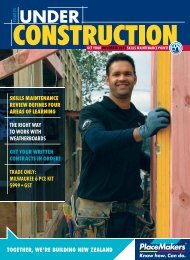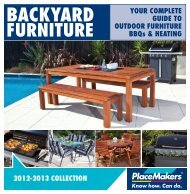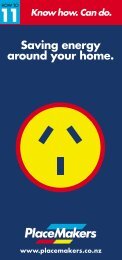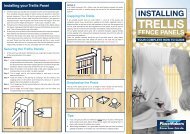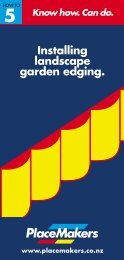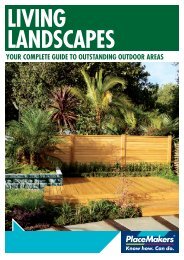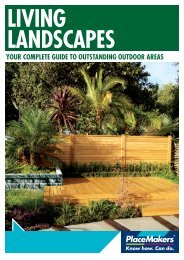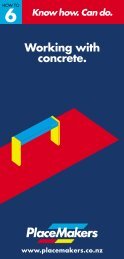what we learned from christchurch taking the risk out ... - PlaceMakers
what we learned from christchurch taking the risk out ... - PlaceMakers
what we learned from christchurch taking the risk out ... - PlaceMakers
You also want an ePaper? Increase the reach of your titles
YUMPU automatically turns print PDFs into web optimized ePapers that Google loves.
FEATURESBRANZRemoving mould-contaminated materialsRecommended steps to reduce biocontaminant exposure when fixing leaky buildingsRecent BRANZ research hasshown that, where leaky buildingsare being repaired, workersare exposed to a cloud of allergenic(causing an allergic reaction),carcinogenic (cancer-causing) andtoxic biocontaminants as <strong>the</strong>y strip <strong>the</strong>cladding and remove mouldy materials.Especially concerning is <strong>the</strong> dangerouslyhigh concentrations of <strong>the</strong> very toxicmould Stachybotrys in <strong>the</strong> cloudgenerated during deconstruction ordemolition. The most dangerous periodof contamination is during removal ofmouldy materials, but workers must bealert through<strong>out</strong> <strong>the</strong> whole process.To reduce exposure to <strong>the</strong>sebiocontaminants, contractors must befamiliar and vigilant with health and safetyprocedures. After consultation with leakybuilding remediation specialists Prendos andAlexander and Co, BRANZ recommends <strong>the</strong>following steps where mould contaminationhas been identified or is expected:• Contamination, decontamination andsafe zones should be established.• Where possible, internal linings andexternal joinery should remain inplace until mould decontaminationis completed, by working <strong>from</strong> <strong>the</strong><strong>out</strong>side, removing cladding and <strong>the</strong>ncontaminated material.• If this is not possible, internal airbarriers with depressurisation of internalcontaminated zones is required tomaintain o<strong>the</strong>r internal safe zones.• Personal protective equipment (PPE),including overalls, safety boots,gloves, helmets, eye protection andWHAT’S THAT ALL ABOUT THEN?respirators, must be worn by all thosein contaminated zones during claddingand mould removal.• Mould should be removed before it isable to dry.• Spores and mycotoxins are likelyto stick to workers’ hair and <strong>the</strong>unprotected areas of <strong>the</strong>ir faces. Aclean decontamination area is requiredfor removal of PPE and washing. Onsitebasins are a minimum requirementto provide for washing before leavingthis zone and entering safe zones orleaving <strong>the</strong> site.To reduce exposureto biocontaminants,contractors must be familiarand vigilant with healthand safety procedures• On highly contaminated sites, specialistadvice must be sought, and on-sitesho<strong>we</strong>rs may have to be provided.• Good practices of overall removal,glove removal and hand washingmust be in place during breaks andafter work. Hands and faces mustbe washed before eating.• Disposable overalls should bedisposed of on site after use or at<strong>the</strong> end of each day.• Disposable gloves are to be usedand disposed of after each use.• Safety boots are to remain on siteat <strong>the</strong> end of <strong>the</strong> day to minimiseTEST YOUR KNOWLEDGE!spore and mycotoxin transfer tovehicles and homes. Alternatively,boots should be thoroughly cleanedbefore removing <strong>the</strong>m <strong>from</strong> <strong>the</strong> site.• Helmets, respirators and eye protectionmust be cleaned after each use withparticular care to wipe <strong>the</strong> inside ofrespirators and eye protection withdisposable <strong>we</strong>t wipes.• Breaks, especially meal breaks, mustbe taken within safe zones and mustnot be taken within <strong>the</strong> building wherecladding is being removed or adjacentto stored or transported contaminatedmaterials (such as <strong>the</strong> skip).• Clean site sheds or separate approvedareas such as a garage must be provided.• Material contaminated with mouldmust be bagged before being placedin skips. Do not break <strong>the</strong>se bags ordisturb contaminated waste by dumpingheavy waste on top!• Truck drivers and o<strong>the</strong>rs tasked withremoving skip bins full of contaminatedmaterials should also <strong>we</strong>ar protectiveclothing or respirators when loadingand unloading.Indoor concentrations of biocontaminantsmay remain high once <strong>the</strong> repair iscomplete, so before handing <strong>the</strong> buildingback to its occupants, it should bethoroughly cleaned to eliminate dustand debris. It should <strong>the</strong>n be tested fornon-viable spore counts and be recleanedif necessary before reoccupation.These recommendations reflect currentindustry best practice and may bemodified once wider research andconsultation has been carried <strong>out</strong>.13) a b c14) a b c15) a b cWhat is Stachybotrys?a) A non-toxic mould found in leakybuildings.b) A very toxic mould found in leakybuildings.c) It’s hard to say.16www.branz.co.nzWhat is cited as <strong>the</strong> most hazardousperiod when repairing leaky buildings?a) When removing mould-contaminatedmaterials.b) When telling <strong>the</strong> homeowner that morework is required than was first thought.c) When working at height.What should you do before handing<strong>the</strong> building back to its occupants?a) Give <strong>the</strong>m <strong>the</strong> number of a localcleaning service.b) Thoroughly clean it to eliminatedust and debris.c) Throw a party.NB: The questions and ans<strong>we</strong>rs in this section have been produced by <strong>the</strong> publisher and do not necessarily reflect views oropinions of <strong>the</strong> contributing organisation.



